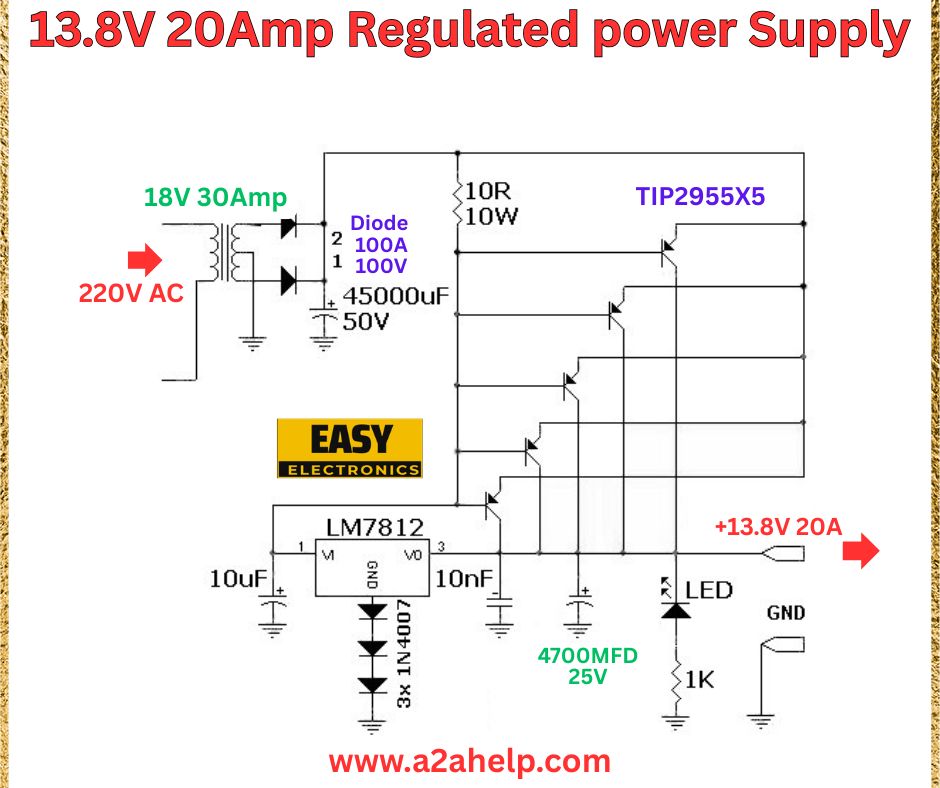Are you looking for a reliable power source for your electronics projects? Building a 13.8V 20Amp regulated power supply is a fantastic DIY project that provides a stable voltage for various applications. In this comprehensive guide, we’ll walk you through constructing this high-current power supply using an LM7812 regulator, TIP2955 transistor, and other essential components. Let’s get started!
Understanding the 13.8V 20Amp Regulated Power Supply
A regulated power supply delivers a consistent voltage and current, making it ideal for powering sensitive electronic devices. The circuit in the image transforms 220V AC into a stable 13.8V DC output capable of delivering up to 20A. This design is perfect for hobbyists and professionals needing a robust power solution.
Components Required
- Step-Down Transformer: 220V to 18V, 30A.
- Diodes: Two 100A diodes for rectification.
- Capacitors: 45000µF (50V), 4700µF (25V), 10µF.
- Resistor: 10Ω (10W), 1kΩ.
- LM7812 Voltage Regulator: For initial voltage regulation.
- TIP2955 Transistor: For high-current amplification.
- 1N4007 Diodes: Three for protection.
- LED: For power indication.
- Connecting Wires and Heat Sink: For assembly and heat management.
Circuit Diagram Analysis
The circuit diagram outlines a clear design for the power supply. Here’s a breakdown of the connections:
- Power Input: A 220V AC supply is stepped down to 18V AC using a 30A transformer.
- Rectification: Two 100A diodes convert AC to DC, producing an unregulated DC voltage.
- Filtering: A 45000µF (50V) capacitor smooths the rectified output to reduce ripple.
- Regulation: The LM7812 regulates the voltage, with a 10µF capacitor for stability. The TIP2955 transistor boosts the current to 20A.
- Output Stage: A 4700µF (25V) capacitor and three 1N4007 diodes stabilize the 13.8V output. An LED with a 1kΩ resistor indicates power status.
- Grounding: Proper grounding ensures safety and stability.

How the 13.8V 20Amp Power Supply Works
The transformer reduces 220V AC to 18V AC. The diodes rectify this to DC, and the 45000µF capacitor filters the output. The LM7812 initially regulates the voltage, while the TIP2955 transistor amplifies the current to meet the 20A requirement. The 4700µF capacitor and diodes ensure a stable 13.8V output, with the LED providing a visual power indicator.
Step-by-Step Assembly
- Set Up the Transformer: Connect the 220V AC input to the transformer’s primary side.
- Build the Rectifier: Wire the two 100A diodes for full-wave rectification.
- Add Filtering: Connect the 45000µF capacitor across the rectified output.
- Install the LM7812: Wire the regulator with a 10µF capacitor, ensuring proper heat sinking.
- Connect the TIP2955: Attach the transistor with a heat sink to handle the 20A current.
- Finalize the Output: Add the 4700µF capacitor, 1N4007 diodes, LED, and 1kΩ resistor.
- Test the Circuit: Apply power and use a multimeter to confirm 13.8V and 20A capacity.
Tips for Optimization
- Heat Management: Use large heat sinks for the TIP2955 and LM7812 to prevent overheating.
- Voltage Adjustment: Fine-tune the output with additional resistors if needed.
- Safety: Enclose the circuit and ensure proper ventilation.
Benefits of a DIY 13.8V 20Amp Power Supply
- Versatile: Powers a wide range of devices and projects.
- Cost-Effective: Save money compared to commercial units.
- Customizable: Adjust for specific voltage or current needs.
Safety Precautions
- Handle 220V AC with care to avoid electric shock.
- Ensure proper grounding to prevent short circuits.
- Monitor heat levels during operation.
Conclusion
Building a 13.8V 20Amp regulated power supply is a rewarding project that provides a stable power source for your electronics endeavors. With the right components and a clear understanding of the circuit, you can create a reliable unit. Visit www.a2help.com for more DIY electronics projects and tutorials. Start building today and power up your creations!
